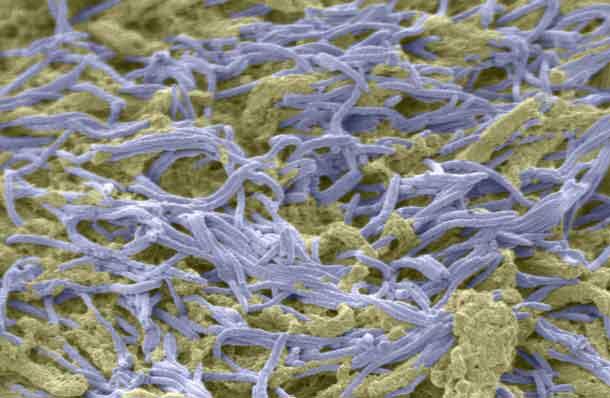Bacterial Biofilms Provide Clues into Colorectal Cancer Risk
, by NCI Staff
Among the various environmental factors believed to contribute to colorectal cancer risk, new data suggest that dense bacterial communities called "biofilms" may play an important role, at least in some regions of the colon.
Biofilms are groups of microbes that grow and stick to each other on a surface. A new study has identified biofilms in the colons of some individuals with colon adenomas and colon cancers. The study findings, published in December in the Proceedings of the National Academy of Sciences, may provide new insights into colon cancer risk, the study authors believe.
Colorectal cancer develops slowly over many years, in close proximity to the largest collection of microbes in the body, and researchers have found evidence suggesting that bacteria in the gut may contribute to the development of colorectal cancer. The results from this study, wrote lead author Cynthia Sears, M.D., and her colleagues from the Johns Hopkins Medical Institutions, provide new clues as to how this might occur.
In the study, the researchers examined normal colon tissue, colon tumors, and precancerous growths in the colon obtained from 118 people undergoing surgery or colonoscopy in Baltimore or at the University of Malaya Medical Centre in Malaysia.
"What was so striking was that these biofilm-positive samples cluster so dramatically in the right colon", Dr. Sears said in a press release. "In fact, it’s virtually a universal feature of tumors that appear in that section of the colon, although we don’t understand why. Although biofilms were present on 13 of 15 cancers from the right colon (89 percent) and all four right-colon polyps (100 percent), they were present on only 2 of 15 left-colon cancers (12 percent) and none of two left-colon polyps."
The researchers found that it was the presence of a biofilm that was most often associated with tumor formation, rather than the presence of a certain species of bacteria, suggesting that the biofilm itself could be the cancer-promoting trigger, they wrote. The presence of biofilms, they also showed, correlated with changes in cellular proliferation and tissue invasion, two basic features of developing tumors. Biofilms may help control these biological changes by promoting inflammation, the authors wrote.
Based on their data, the researchers categorized individuals with adenomas and colon cancer into two broad categories: those with and those without biofilms. They calculated that the risk of developing colorectal cancer was more than fivefold higher in individuals with biofilms compared with those without biofilms.
The results suggest the structural organization of microbes as a whole, instead of specific types of microbes, might contribute to colorectal cancer progression, Dr. Sears said. Furthermore, she continued, biofilms produced by the organized microbes might aid in early diagnosis.
The researchers plan to examine biofilms in the same individuals for at least 5 years, Dr. Sears explained, "to see if we can understand the dynamics of their formation, persistence, and relationship to early cancer development."
